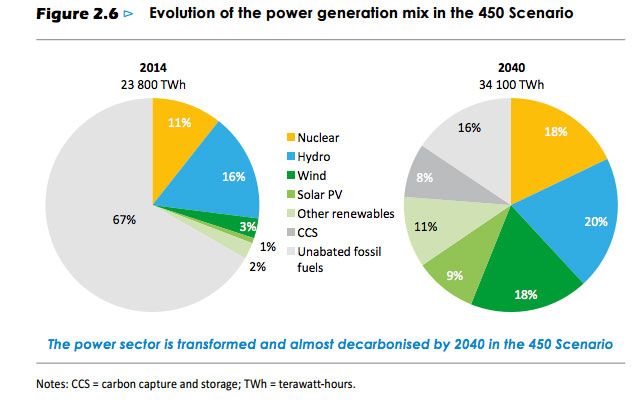The world will need to invest $44 trillion in the global energy supply, and another $23 trillion in energy efficiency, to cover the growth in energy demand through 2040 and meet current policy goals.
The findings from the International Energy Agency’s newly released World Energy Outlook only take into account policies put in place by mid-2016, and so they do not include any pledges as part of the Paris climate agreement that have not yet been codified as policy. The IEA states that with current policies, “This is sufficient to slow the projected rise in global energy-related CO2 emissions, but not nearly enough to limit warming to less than 2 [degrees Celsius].”
Of the $44 trillion, only about 20 percent will go to renewable energy under the business-as-usual scenario. The investment will not only fail to meet the target of limiting global warming to 2 degrees Celsius, but it will also leave hundreds of millions of people without basic energy services up through 2040. Currently, about 1.2 billion people lack basic access to electricity, and more than a billion additional people only have unreliable access to modern energy services.
The report was also issued before the most recent U.S. election, which has thrown into question the United States' degree of commitment to the Paris Agreement. Without investment and commitment from the U.S., other countries would likely have to step up their efforts even further. The IEA would not comment on how the recent U.S. elections could alter its forecasts.
To get to even a 50-50 chance of achieving the Paris climate goals of limiting temperature rise to 2 degrees Celsius, it would not require more investment, according to the IEA. In fact, the investment would be $4 trillion less for energy supply, although energy efficiency spend would need to rise by $12 trillion to $35 trillion by 2040.
The 50-50 chance, labeled the 450 scenario by IEA, could be possible if the Paris Agreement is largely held up and most policy pledges are enacted. Fossil fuels would be slashed from roughly three-quarters of the world’s energy mix to one-third in 2040.

The Paris goals would “require a step-change in policy action in the direction of much more efficiency and higher reliance across different end-uses on low- or zero-carbon electricity,” according to IEA.
Most importantly, it requires clean energy to permeate not only the electricity supply, but also freight, air and maritime transport and industrial processes. In particular, efficiency in electric motors could contribute significantly to any future cuts in energy demand growth.
“The additional cumulative investment of around $300 billion for efficiency improvements in industrial electric motor systems in the 450 Scenario is far outweighed by avoided investment in power generation of $450 billion,” IEA states.
The question is whether there will be a continued global commitment to the types of system-wide efficiency that will be needed to realize the goals set in Paris. Beyond the commitment to efficiency that would be needed, IEA warns that decarbonizing the rest of the energy sector is an immense task.
But even electric vehicles, biofuels and rising fuel-economy standards will not be enough to decarbonize transportation given the technology available today, the IEA report states: “The unavoidable conclusion is that there is an urgent need for immediate radical reductions in energy sector CO2 emissions if there is to be any chance of achieving the 1.5 [degrees Celsius] goal.”
Check out these stories for more on the changing global outlook for energy:



